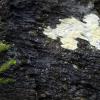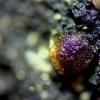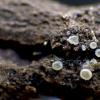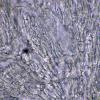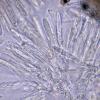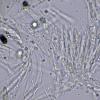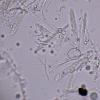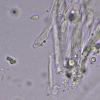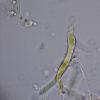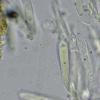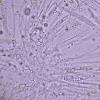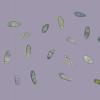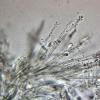
21-08-2025 02:18
Stefan JakobssonOn a necrotic section of a living Tilia cordata I

20-08-2025 19:04
Ethan CrensonHello, This asco was found on the same wood as my

19-08-2025 20:58
Ethan CrensonHi all, Here is what I believe to be a Hymenoscyp

12-08-2025 19:44
Could someone send me a pdf copy of this article?S

18-08-2025 15:17
 Lothar Krieglsteiner
Lothar Krieglsteiner
... on 6.7.25 in a subarctic mire near a small lak

18-08-2025 15:07
 Lothar Krieglsteiner
Lothar Krieglsteiner
.. 20.7.25, in subarctic habital. The liverwort i

19-08-2025 16:27
Paul CannonHello all I have spent some time trying to work o

18-08-2025 22:59
Yanick BOULANGERBonsoirVoici un asco récolté le 08/08/2025Comme

18-08-2025 16:01
 Lothar Krieglsteiner
Lothar Krieglsteiner
.. on water-soaked Betula wood lying in a small st
Whitish Discomycete
Josep Torres,
19-05-2025 09:42
An ascomycete photographed on April 20, sprouting on the surface of a decaying trunk lying on the ground, most likely an oak tree.
Whitish apothecia, turning ochre with maturation or dehydration, with a diameter of 0.2 to 0.4 mm, sprouting scattered but abundantly on the trunk surface.
The apothecia react with KOH to an intense reddish yellow.
Hyphae of the exciple are roughly rectangular, suggesting a parallel arrangement.
Osctosporic asci, apparently with hooks at their bases and amyloid reaction of their tiny apical apparatus with Melzer's reagent, measuring 42.9–51.2 × 5–6.5 µm.
Paraphyses with contents inside, this content most visible in water.
Ascospores are cylindrical to fusiform, with a slightly granular interior. Free spore measurements in water are:
(4.6) 6 - 8.2 (8.9) × (2) 2.3 - 3.2 (3.7) µm
Q = (2) 2.3 - 3 (3.1) ; N = 30
Me = 7.2 × 2.8 µm ; Qe = 2.6
Thank you very much in advance for your opinion.
Best regards.
Lothar Krieglsteiner,
19-05-2025 09:56

Re : Whitish Discomycete
A Mollisia? No. A Mollisia has an excipulum of dark textura globulosa, here I see a hyaline prismatica. Mollisia has distinct vacuolar bodies in its paraphyses, here they seem to lack.
Unfortunately, you do not show the (marginal) hairs (or do I overlook them?). Otherwise I would suggest a Hyaloscypha or something related (?). I do not have a species of any possible genus with a KOH-reaction in my mind. But perhaps somebody else does ...
Best regards, Lothar
Unfortunately, you do not show the (marginal) hairs (or do I overlook them?). Otherwise I would suggest a Hyaloscypha or something related (?). I do not have a species of any possible genus with a KOH-reaction in my mind. But perhaps somebody else does ...
Best regards, Lothar
Enrique Rubio,
19-05-2025 11:43
Re : Whitish Discomycete
Hola Josep.
Creo que habría que descartar Mollisia porque el excípulo no posee una textura globulosa (angularis). Yo pienso en Hyaloscypha por los largos y densos pelos, pero desgraciadamente no se ven imágenes de ellos y por tanto es muy difícil asegurarlo.
Saludos.
Creo que habría que descartar Mollisia porque el excípulo no posee una textura globulosa (angularis). Yo pienso en Hyaloscypha por los largos y densos pelos, pero desgraciadamente no se ven imágenes de ellos y por tanto es muy difícil asegurarlo.
Saludos.
Josep Torres,
19-05-2025 14:25
Re : Whitish Discomycete
Thank you both very much.
I've studied Hyaloscypha aureliella on eight occasions. I don't understand why I haven't considered it. Perhaps it's because I've found it on pine wood on all the previous occasions, a species that is, by the way, very abundant on this substrate.
I'm adding an image of what I believe to be the marginal hairs in water.
Best regards.
I've studied Hyaloscypha aureliella on eight occasions. I don't understand why I haven't considered it. Perhaps it's because I've found it on pine wood on all the previous occasions, a species that is, by the way, very abundant on this substrate.
I'm adding an image of what I believe to be the marginal hairs in water.
Best regards.
Enrique Rubio,
19-05-2025 14:31
Re : Whitish Discomycete
OK. Hairs typical for Hyaloscypha. But be aware that aureliella seems to live only on coniferous wood and its hairs are covered with a yellowish resinous exudate.
Lothar Krieglsteiner,
19-05-2025 14:32

Re : Whitish Discomycete
Hello Josep,
yes - those are typical Hyaloscypha-hairs.
Yours, Lothar
yes - those are typical Hyaloscypha-hairs.
Yours, Lothar
Josep Torres,
20-05-2025 07:42
Re : Whitish Discomycete
Thank you both very much.
For Enrique, I don't remember seeing any pine trees in the area where I found it, but when I return to the area I'll be more attentive. If the possibility of the wood being coniferous is confirmed, we'll have no doubts. For now, I'm leaving it as Hyaloscypha cf. aureliella.
Best regards.
For Enrique, I don't remember seeing any pine trees in the area where I found it, but when I return to the area I'll be more attentive. If the possibility of the wood being coniferous is confirmed, we'll have no doubts. For now, I'm leaving it as Hyaloscypha cf. aureliella.
Best regards.
Kosonen Timo,
21-05-2025 12:17

Re : Whitish Discomycete
Hi,
Howabout Hyaloscypha daedalea - seems like a good match?
t. Timo
Howabout Hyaloscypha daedalea - seems like a good match?
t. Timo
Josep Torres,
21-05-2025 14:16
Re : Whitish Discomycete
Hi Timo.
If the complete absence of pines in the area is confirmed, as I suspect, and I've always thought it would be limited to oaks and holm oaks, Hyaloscypha daedaleae seems like a very good option.
Thank you very much for your opinion.
Best regards.
If the complete absence of pines in the area is confirmed, as I suspect, and I've always thought it would be limited to oaks and holm oaks, Hyaloscypha daedaleae seems like a very good option.
Thank you very much for your opinion.
Best regards.

